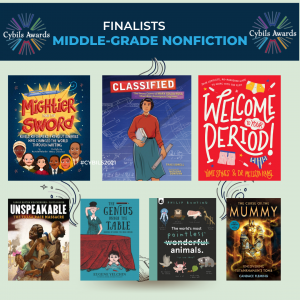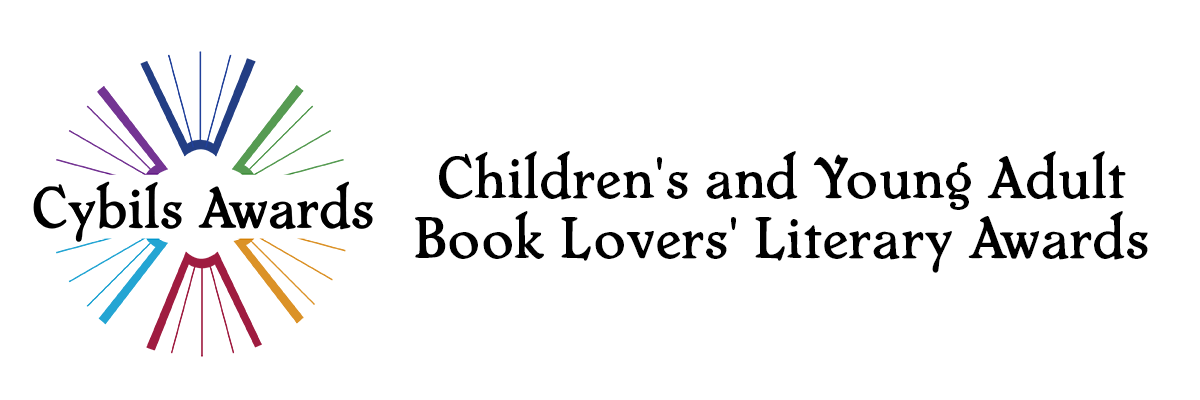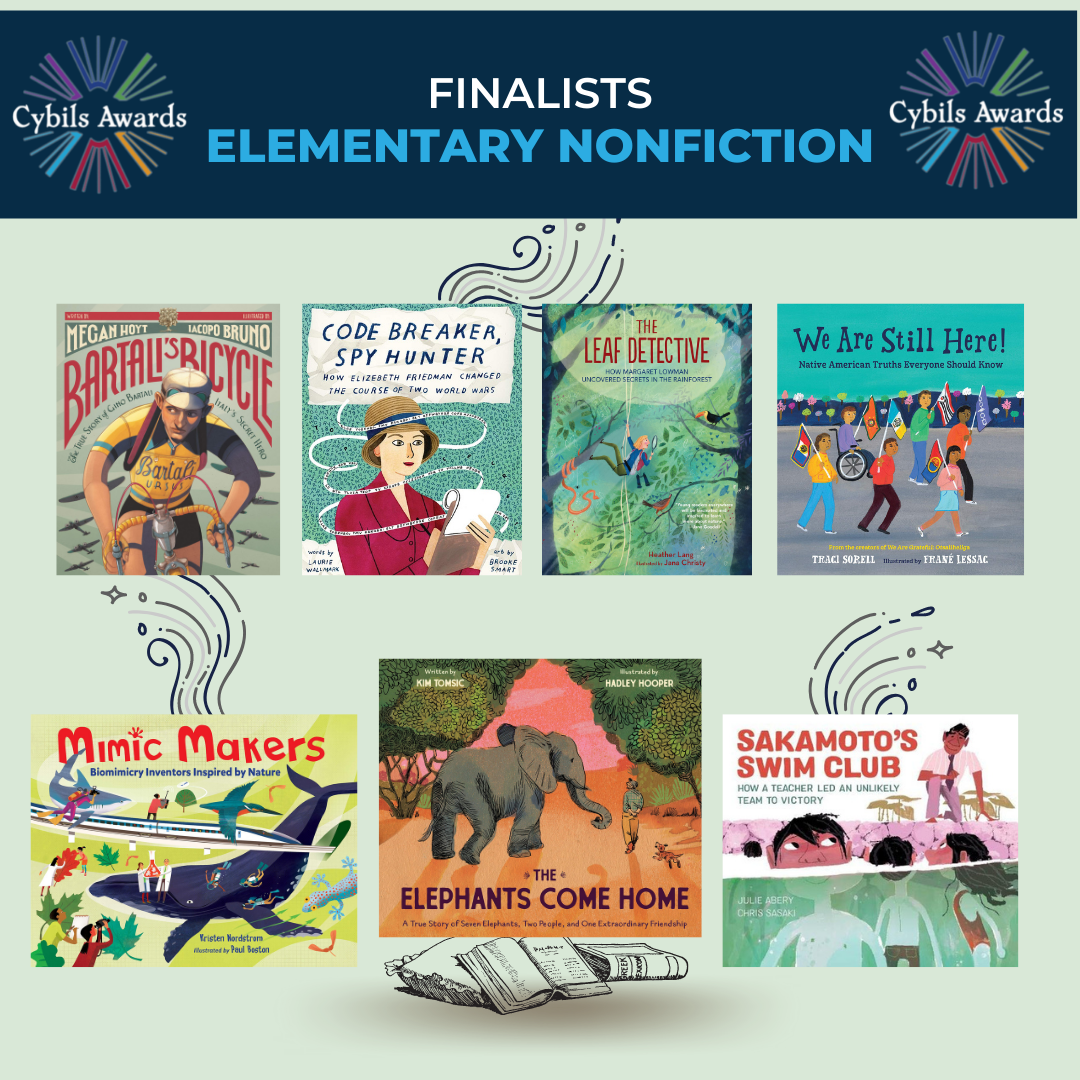Elementary Nonfiction

Bartali’s Bicycle: The True Story of Gino Bartali, Italy’s Secret Hero
by Hoyt, Megan, illustrated by Bruno, Iacopo
Quill Tree Books
Nominated by: Julie Rowan-Zoch
Gino Bartali won the Tour de France in 1938 and became an international hero, however he always insisted he was not a hero, simply a cyclist. However, in the years to come he would truly become a hero to all of Italy. This is his courageous story.
When Germany invaded Italy in 1943, Gino was appalled to see his Jewish friends and neighbors rounded up and sent away and knew he must help. In light of this desire, his friend, the Archbishop Dalla Costa, invited Gino to join a secret network of Italians helping Jewish families escape the country. Gino would deliver forged identity papers to people hiding in every corner of Italy. For a year he simply concealed the papers in the hollow bars of his bike, rode across the country, sometimes 250 miles a day, delivering the secret documents and saving more than 800 people. Gino went on to win the Tour de France again in 1948 and never shared his story, rather simply choosing to talk about cycling. However, grateful families remembered his heroism and his story began to emerge.
The engaging prose in this inspiring story is brought alive by Iacopo Bruno’s bold illustrations which have an art deco feel. It also includes truly remarkable back matter of a detailed timeline, a letter from Gino Bartali’s granddaughter and a note from the author describing how she first learned about Gino’s story, as well as details about DELASEM (Delegation for the Assistance of Jewish Emigrants), of which he was a part.
This book for grades 4 and up, is one to read aloud (including in high school) to introduce a
World War II units, Holocaust education or as an example of a person with quiet courage who faces and works against injustice. It’s a book to add to the collections of elementary through high school libraries.

Code Breaker, Spy Hunter: How Elizebeth Friedman Changed the Course of Two World Wars
by Wallmark, Laurie, illustrated by Smart, Brooke
Abrams Books for Young Readers
Nominated by: Pat Zietlow Miller
Like an intriguing cipher, this picture book biography will grab your attention right away! Growing up, Elizabeth developed a love for poetry and a passion for foreign languages. Later, she joined a team looking for secret messages in Shakespeare’s plays. It’s on this project that she met and fell in love with William Friedman. They worked together to invent the techniques that are now considered the building blocks of modern cryptology. Throughout her life, Elizabeth employed her expert decoding skills to help catch a number of criminals and spies. While her work was labeled “Top Secret Ultra” for 35 years, it has now been declassified and we can see how she helped to end both WWI and WWII and saved thousands of lives. The watercolor and gouache illustrations incorporate many of Elizabeth’s inspiring quotes and strike a powerful balance between the feminine, maternal, and professional elements of her life. The back matter includes more to learn on the subject of codes and ciphers, a description of modern cryptography, a timeline, a bibliography and even an opportunity to take a crack at solving an actual encoded message.

Mimic Makers: Biomimicry Inventors Inspired by Nature
by Nordstrom, Kristen, illustrated by Boston, Paul
Charlesbridge
Nominated by: Claire Annette Noland
MIMIC MAKERS: Biomimicry Inventors Inspired by Nature offers an intriguing look at ten diverse inventors/innovators whose remarkable developments began through childlike observations and wonder. In some cases, it was actual childhood fascination that led to adult careers and inventions. Other profiles indicate that established adult experts retained a childlike perspective on nature that sparked curious investigations that challenged existing approaches to the built world. Among developments that can benefit young readers now and in their futures, these innovators represent architects, botanists, biologists and microbiologists, engineers (chemical, design, electrical,and materials), and zoologists. The opening spread poses questions about kingfishers who dive into water without splashing, why maple seeds twirl or whale’s flippers are bumpy, how a gecko can defy gravity to walk on walls and even ceilings. The term “mimic-makers” is defined as those who marvel at nature’s brilliance and then seek ways to incorporate/adapt Nature’s designs in new devices and machines that function better for humans. Their innovations have led to improvements in energy turbines, solar cells, medical equipment, safe and accessible drinking water, and other remarkably clever and practical developments. Both levels of text ( large font “big questions” and related expository text about the specific observer/invention) are engaging, especially in combination with colorful and high- energy illustrations that make applied science as exciting as nature itself. The author note and back matter provide added details, but also sound a challenge to young readers to observe closely now, and to never lose that fascination and curiosity that could inspire their own inventions to make life better for years to come, beginning today to pursue their inner mimic-makers.

Sakamoto’s Swim Club: How a Teacher Led an Unlikely Team to Victory
by Abery, Julie, illustrated by Sasaki, Chris
Kids Can Press, Ltd
Nominated by: Amber
Sakamoto’s Swim Club: How a Teacher Led an Unlikely Team to Victory is a pithy and poetic story of how a group of kids that science teacher Soichi Sakamoto found swimming in ditches in Maui were led to become Olympic swimmers in 1948. The story talks about how Sakamoto convinced the plantation foreman to allow the children to keep swimming if he trained them. Gradually learning better techniques and gaining momentum, this underdog team surprised everyone by becoming successful, and Julie Abery and Chris Sasaki work seamlessly as their own creative team. While the main text offers a very basic version of the story, perfect for picture book readers, the illustrations and the author’s note at the back carry the rest of the narrative forward. Dynamic bird’s eye views of swimmers curving through plantations in their one-lane ditch, with roosters watching their strokes, and innovative paintings of the action keep readers turning the pages.

The Elephants Come Home: A True Story of Seven Elephants, Two People, and One Extraordinary Friendship
by Tomsic, Kim, illustrated by Hooper, Hadley
Chronicle Books
Nominated by: Aimee Smith
The Elephants Come Home: A True Story of Seven Elephants, Two People, and One Extraordinary Friendship is a beautiful picture book depicting an extraordinary story of friendship between humans and elephants. It tells the story of how Lawrence and Francoise created a safe haven for a herd of lost and troubled elephants. It’s true that home is where the heart is, and this group of rescued elephants found their home in the forests of Thula Thula; a sanctuary created by Lawrence and Francoise.
When the elephants arrive at Thula Thula, they stomp and break the fences and destroy their temporary abode. Lawrence realizes that the herd is scared and angry. So he adapts to the situation and whispers to the herd leader, using soothing words to calm them down. Finally, slowly but surely, the herd starts trusting Lawrence and listening to his words. This gentle tale turns fascinating many years later when tragedy strikes.
Beautifully illustrated, the watercolor images capture the mood, the serenity of Thula Thula. When you finish reading this book, you will wonder if this is indeed a true story! The author shares a little blurb on the back matter with actual pictures of these elephants, the events that unfolded and of the people involved.

The Leaf Detective: How Margaret Lowman Uncovered Secrets in the Rainforest
by Lang, Heather, illustrated by Christy, Jana
Calkins Creek Books
Nominated by: Sandy Brehl
“We had already been to the moon and back and nobody had been to the top of a tree” – At least not in the Amazon. So in the 1970s, young field biologist Margaret “Canopy Meg” Lowman decided to be the first pioneer.
With Jana Christy’s magical illustrations and Heather Lang’s gentle prose, THE LEAF DETECTIVE discusses the magic nature held for little girl Meg; and addresses the misogyny she faced in college and as a female trailblazer in her field in a matter-of-fact way.
Peppered with fun facts about rainforests (printed on leaves, of course), this picture book has enough variance of text and illustration to engage children across a broad age range.
Lang presents trees and the rainforest canopy as the magnificent and misunderstood creatures they are, introducing the concepts of biodiversity, medicinal plants, and the scientific method in accessible language that will intrigue young readers.
THE LEAF DETECTIVE is not just a story of scientific exploration and discovery, but a story of belief in oneself and investment in others.

We Are Still Here!: Native American Truths Everyone Should Know
by Sorell, Traci, illustrated by Lessac, Frane
Charlesbridge
Nominated by: OKteacher
Native Nations are still here. Using children’s presentations as a backdrop, Traci Sorell takes readers on a journey through some of the awful things that Native peoples have experienced over the centuries since Europeans arrived on the North American continent. The U.S. Government’s treatment of Native Nations generally focused on forcing them to leave their lands and assimilate. Numerous broken treaties left indigenous peoples on reservations having been driven from their homes. While some helpful laws were passed during the Great Depression, things took a turn for the worse in the years following when the U.S. government decided to stop honoring treaty agreements with over a hundred Native Nations. While facing these and other challenges, Sorell emphasizes the fact that the Native Nations are still here, despite the efforts to wipe them out or force them to assimilate. Native Nations continue to stand up for their rights and their sovereignty. Sorell deftly includes a lot of information while sticking to her theme of survival and overcoming challenges. Lessac’s illustrations do an excellent job of highlighting some of the events that Sorell mentions in her text. The backmatter includes sources, a timeline, additional information about the illustrations, and an author’s note.
 Middle Grade Nonfiction
Middle Grade Nonfiction

Classified: The Secret Career of Mary Golda Ross, Cherokee Aerospace Engineer
by Sorell, Traci, illustrated by Donovan, Natasha
Millbrook Press
Nominated by: Mary Duffy
Just like Mary stood out among her peers as the first Native American female engineer, this picture book biography stands out as a much needed addition to the STEM genre. In the 1920’s, Mary was a teenager who defied expectations and succeeded in the fields of math and science. She went on to become a teacher, an engineer for top-secret projects, and a trail blazer committed to helping the next generation of female American Indian engineers. Sorell, a member of the Cherokee Nation herself, specifically ties these successes to four deeply rooted Cherokee values: “gaining skills in all areas of life (both within and outside the classroom), working cooperatively with others, remaining humble when others recognize your talents, and helping ensure equal education and opportunity for all.” The period-specific illustrations help bring Mary to life, and include details of many of her tools, equations, and blueprints. Even though much of her work remains classified, young readers will be inspired by her example of persistence, service and humility.

Mightier Than the Sword: Rebels, Reformers, and Revolutionaries Who Changed the World Through Writing
by Melander, Rochelle, illustrated by Ontiveros, Melina
Beaming Books
Nominated by: Sandy Brehl
This inviting, easy to read compilation of writings by forty “rebels, reformers and revolutionaries who changed the world” will be an inspiration to aspiring middle grade writers. Each entry includes a brief biography of the writer, a quotation from the writer and a writing prompt, such as “write a prose poem about a significant event in your life, using figurative language”. Some entries include definitions of writing terms, for example, figurative language, metaphors and similes. Colorful and appealing illustrations accompany each entry and some even include short biographies of modern day writers who made similar contributions to the world. There is a detailed table of contents with the title of the writer’s work, as well as the years of their lives. The last twenty pages of the book are devoted to examples of notable speeches (some by kids and young adults), as well as helpful tips on how to begin to write and revise. It concludes with words of advice from 14 notable writers.
This remarkable resource needs to be on the shelves of elementary, middle school and public libraries as well in classroom collections. You’ll need lots of copies!

The Curse of the Mummy: Uncovering Tutankhamun’s Tomb (Scholastic Focus)
by Fleming, Candace
Scholastic Focus
Nominated by: Heidi G.
In “The Curse of the Mummy: Uncovering Tutankhamun’s Tomb”, author Candace Fleming weaves in the race to find hidden treasures of Egypt and the battle for their ownership with the wild stories behind the “curse” of the mummies. Read this book to find the REAL story behind the discovery of King Tut’s tomb in the Valley of the Kings. This narrative nonfiction title is superbly told and almost reads like a historical fiction novel. Candace Fleming keeps the reader’s interest by walking us through the historical timeline of the discovery; but intersperses the narrative with conspiracies as they unfold. Every chapter follows with a breakout chapter highlighting these misinformed stories. For example, it is “widely” known that there was a curse etched on King Tut’s tomb. Or was it? Sensational newspapers told about the mummy’s curse that haunted the treasures that were taken from the tomb. What was really behind this curse? Read on to find out more!
I enjoyed reading about Howard Carter the chief archeologist and his lifetime’s work behind the discovery. His relationship with Lord Carnarvon who funded the entire expedition was interesting to read. More importantly though I applaud the author for highlighting the Egyptian colonialism and British attitude towards the people of the land.
Finally for many of us we travel in time through the black and white photographs taken from the discovery. I felt I was right there alongside Lord Carnarvon and Cater when they found King Tut’s mummy!

The Genius Under the Table: Growing Up Behind the Iron Curtain
by Yelchin, Eugene, illustrated by Yelchin, Eugene
Candlewick Press
Nominated by: Christopher Helton
Take Portrait of the Artist as a Young Man, but make it mid-century Soviet and make the main character funny, creative, and relatable; and add strong messages of self-esteem and self-discovery. You’ll get Newberry Award Winner Eugene Yelchin’s THE GENIUS UNDER THE TABLE: Growing up Behind the Iron Curtain.
A teenager in 1970’s Leningrad, Yevgeny (Eugene) is desperate to discover his artistic talent. It’s the only way out of a very scary life behind the Iron Curtain – whose horrors are related in an age-appropriate way, that still pulls no punches. Fortunately for Generation X and later, Yevgeny steals his dad’s pencils and draws under his wisecracking grandmother’s table in between his much-loathed ballet classes. But along the way of finding his talents, Yevgeny learns a lot about truth, mysteries, creativity, and life, which will leave the reader in chills long after closing the book. With short chapters with visual interest on every page, this book will engage a reluctant reader.

The World’s Most Pointless Animals: Or are they?
by Bunting, Philip
Happy Yak
Nominated by: Melissa Fox
A cheeky double voice is what makes The World’s Most Pointless Animals: Or Are They? simultaneously sound like a wildlife documentary and someone poking fun at the narrator. Phillip Bunting’s book waxes poetic about a series of animals that are perfectly adapted for their perfectly balanced ecosystems. This guide to everything from jellyfish and qokkas, leeches and naked mole rats, the axolotl and the kiwi bird, and it raves about how wonderful each creature is, but the panegyric is interrupted by crossings out that claim these creatures are all pointless. The second voice in the book makes fun of each creature’s features in turn, and even makes up fake scientific names like “wingus rattus” for pigeons or “annoyus maximus” for mosquitoes. This ironic repartee makes the lyricism of the book palatable and funny for all ages. The cartoon-style illustrations of each animal attract repeat viewings. A highly recommended read aloud or a coffee table book you can page through any time.

Unspeakable: The Tulsa Race Massacre
by Weatherford, Carole Boston, illustrated by Cooper, Floyd
Carolrhoda Books
Nominated by: Patricia Tilton
In the early 1900s, the discovery of oil lead to the rapid growth of Tulsa, Oklahoma. Despite rampant discrimination and legal segregation, the black community centered on Greenwood Avenue developed into a booming business district. Black Wall Street housed restaurants and grocery stores, a pool hall, a hospital, several libraries, and a separate school system. Two black-owned newspapers and doctors, lawyers, and businessmen called Greenwood home. Many white residents resented the success of the black community. This resentment grew until a spark caused it to erupt into violence on May 31 and June 1, 1921. An accusation of assault by a white girl against a black boy led to the boy’s imprisonment and a confrontation between a small group of armed blacks against a large mob of armed whites in front of the jail. Unable to get their hands on the black boy, the mob turned their attention to Greenwood. Dozens of people were killed, hundreds of homes and businesses were destroyed through looting and fire. In the end it’s estimated that 150-300 people died and 8000 people were left homeless. Local leaders did everything in their power to cover up their involvement and what came to be called the Tulsa Race Massacre wasn’t even taught in schools until the 2000s. This stunning book highlights the growth of Greenwood and its destruction. Weatherford’s beautiful writing is complimented gorgeously by Cooper’s amazing illustrations. The story is honestly told without becoming too graphic for the intended audience. A beautiful book that highlights an important event in United States history.

Welcome to Your Period!
by Stynes, Yumi and Kang, Dr. Melissa, illustrated by Latham, Jenny
Walker Books for Young Readers
Nominated by: Beth Mitcham
It is not easy to approach a topic surrounded by subtlety and silence but one that is ubiquitous in the lives of uterus-owning humans. The two authors are steeped in legitimacy of expertise and authoring, combining to produce a user-friendly (by KIDS AND ADULTS!) text that can be read front-to-back, dipped into for specific purposes, and carried/discussed freely among and across generations. This blends actual letters (with commentary and questions) with informative text, illustrations that embrace the reality of diverse human bodies and identities, and direct language that consistently conveys empowerment, positivity, and embracing identity.
It reached the high bar of: This Book Is Anti-Racist: 20 Lessons on How to Wake Up, Take Action, and Do the Work (by Tiffany Jewell, Aurelia Durand) in balancing conversational and academic language and style with confidence and commitment.
I highly encourage everyone to read this, including grown adults of both/any gender. This straightforward insights to half the world’s population is long overdue.



